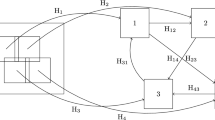Abstract
We describe an algorithm for generating spherical mosaics from a collection of images acquired from a common optical center. The algorithm takes as input an arbitrary number of partially overlapping images, an adjacency map relating the images, initial estimates of the rotations relating each image to a specified base image, and approximate internal calibration information for the camera. The algorithm's output is a rotation relating each image to the base image, and revised estimates of the camera's internal parameters.
Our algorithm is novel in the following respects. First, it requires no user input. (Our image capture instrumentation provides both an adjacency map for the mosaic, and an initial rotation estimate for each image.) Second, it optimizes an objective function based on a global correlation of overlapping image regions. Third, our representation of rotations significantly increases the accuracy of the optimization. Finally, our representation and use of adjacency information guarantees globally consistent rotation estimates.
The algorithm has proved effective on a collection of nearly four thousand images acquired from more than eighty distinct optical centers. The experimental results demonstrate that the described global optimization strategy is superior to non-global aggregation of pair-wise correlation terms, and that it successfully generates high-quality mosaics despite significant error in initial rotation estimates.
Similar content being viewed by others
References
Antone, M. and Teller, S. 2000. Automatic recovery of relative camera rotations for urban scenes. In CVPR, 2000 Vol. II, pp. 282–289.
Coorg, S. 1998. Pose imagery and automated three-dimensional modeling of urban environments. Ph.D. Thesis, MIT.
Coorg, S., Master, N., and Teller, S. 1998. Acquisition of a large pose-mosaic dataset. In CVPR’ 98, pp. 872–878.
Coorg, S. and Teller, S. 1999. Extracting textured vertical facades from controlled close-range imagery. In CVPR’ 99, pp. 625–632.
Faugeras, O. 1993. Three-Dimensional Computer Vision. MIT Press.
Hartley, R. 1997. Self-calibration of stationary cameras. IJCV, 22(1):5–23.
Heckbert, P. 1989. Fundamentals of texture mapping and image warping. Technical Report UCB/CSD 89/516, CS Division, UC Berkeley.
Horn, B.K.P. 1986. Robot Vision. MIT Press: Cambridge, MA.
Horn, B.K.P. 1987. Closed-form solution of absolute orientation using unit quaternions. Journal of the Optical Society of America A, 4(4).
Horn, B.K.P. 1991. Relative orientation revisited. Journal of the Optical Society of America A, 8(10):1630–1638.
Hsu, S. and Sawhney, H. 1998. Influence of global constraints and lens distortion on pose and appearance recovery from a purely rotating camera. In Workshop on Applications of Computer Vision, pp. 154–159.
Kropp. A., Master, N., and Teller, S. 2000. Acquiring and rendering high-resolution spherical mosaics. In Proceedings IEEEWorkshop on Omni Direction Vision, pp. 47–53.
Lenz, R. and Tsai, R. 1987. Techniques for calibration of the scale factor and image center for high accuracy 3D machine vision metrology. In Proc. IEEE International Conf. on Robotics and Automation.
McMillan, L. 1997. An image-based approach to three-dimensional computer-graphics. Ph.D. Thesis, Dept. of Computer Science, Univ. of North Carolina (Chapel Hill).
McMillan, L. and Bishop, G. 1995. Plenoptic modeling: An imagebased rendering system. In SIGGRAPH’ 95 Conference Proceedings, pp. 39–46.
Paeth, A. 1990. Digital cartography for computer graphics. In Graphics Gems, A. Glassner (Ed.), pp. 307–320. AP Professional.
Press, W.H., Teukolsky, S.A., Vetterling, W.T., and Flannery, B.P. 1992. Numerical Recipes in C: The Art of Scientific Computing (2nd ed.). Cambridge University Press: Cambridge.
Sawhney, H., Hsu, S., and Kumar, R. 1998. Robust video mosaicing through topology inference and local to global alignment. In European Conference on Computer Vision, pp. 103–119.
Sawhney, H.S. and Kumar, R. 1999. True multi-image alignment and its application to mosaicing and lens distortion correction. IEEE Transactions on Pattern Analysis and Machine Intelligence, 21(3):235–243.
Scales, L.E. 1985. Introduction to Non-Linear Optimization. Springer-Verlag.
Shum, H.-Y. and Szeliski, R. 1998. Construction and refinement of panoramic mosaics with global and local alignment. In Proceedings of Sixth ICCV, pp. 953–958.
Stein, G.P. 1995. Accurate internal camera calibration using rotation, with analysis of sources of error. In ICCV95, pp. 230–236.
Strang, G. 1998. Linear Algebra and Its Applications. Harcourt Brace Jovanovich.
Szeliski, R. 1996. Video mosaics for virtual environments. IEEE Computer Graphics and Applications, 16(2):22–30.
Szeliski, R. and Shum, H. 1997. Creating full-view panoramic mosaics and texture-mapped 3D models. In SIGGRAPH’ 97 Conference Proceedings, pp. 251–258.
Teller, S. 1997. Automatic acquisition of hierarchical, textured 3D geometric models of urban environments: Project plan. In Proceedings of the Image Understanding Workshop.
Tsai, R. 1987. A versatile camera calibration technique for high accuracy 3D machine vision metrology using off-the-shelf TV cameras and lenses. IEEE Journal of Robotics and Automation, RA-3(4).
Wheeler, M. and Ikeuchi, K. 1995. Iterative estimation of rotation and translation using the quaternion. Technical Report CMU-CS-95-215, Carnegie Mellon University.
Zoghiami, I., Faugeras, O.P., and Deriche, R. 1997. Using geometric corners to build a 2D mosaic from a set of images. In CVPR97, pp. 420–425.
Author information
Authors and Affiliations
Rights and permissions
About this article
Cite this article
Coorg, S., Teller, S. Spherical Mosaics with Quaternions and Dense Correlation. International Journal of Computer Vision 37, 259–273 (2000). https://doi.org/10.1023/A:1008184124789
Issue Date:
DOI: https://doi.org/10.1023/A:1008184124789




